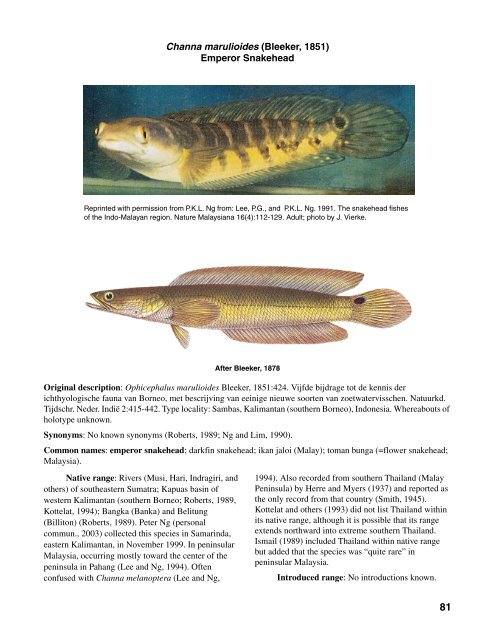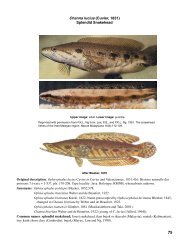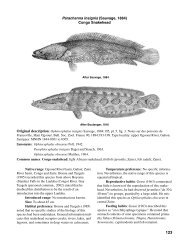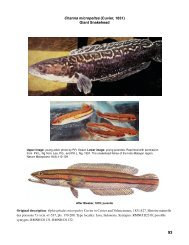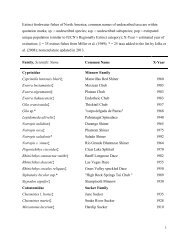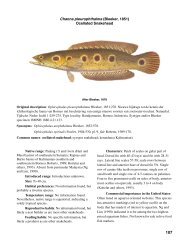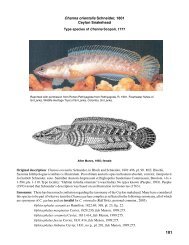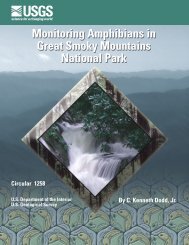Channa marulioides (Bleeker, 1851) Emperor Snakehead - USGS
Channa marulioides (Bleeker, 1851) Emperor Snakehead - USGS
Channa marulioides (Bleeker, 1851) Emperor Snakehead - USGS
- No tags were found...
You also want an ePaper? Increase the reach of your titles
YUMPU automatically turns print PDFs into web optimized ePapers that Google loves.
<strong>Channa</strong> marulius, from Khao Laem Reservoir, Kanchanaburi Province, Thailand, June 2002. Photo courtesyof Jean-Francois Helias, Fishing Adventures Thailand.with increasing age in specimens from River Kali innorthern India. Wee (1982) cited C. marulius andC. micropeltes as the two fastest growing snakeheads.Habitat preference: Lakes and rivers; deep,clear water with sand or rocky substrate (Talwar andJhingran, 1992); “rivers usually in the vicinity of mudor fine sands” (Sen, 1985); “deep pools in rivers andoccasionally in lakes” (Pethiyagoda, 1991). Jhingran(1984) noted presence of this species in swamps, tanks(=small reservoirs), and ponds, but that it also “prefersdeep, clear stretches of water with sandy or rockybottom.” Rainboth (1996) listed preferred habitat as“sluggish or standing water in canals, lakes, andswamps from India to China, south to Thailand andCambodia.” He added that it is often found withsubmerged aquatic vegetation.Temperature range: No specific information inliterature. Native range of the species is from about34º N to 7º N, indicating a species that can exist intemperate to tropical conditions. Preliminary temperaturetesting on individuals from the established southeasternFlorida population indicated the lower range tobe about 10 ºC (Paul L. Shafland, personal commun.,2002), suggesting that this population did not originatefrom northern reaches of the native range of thisspecies.Reproductive habits: Breder and Rosen (1966)summarized brood size from Chacko and Kuriyan(1947) as being about 500 young with parents guardingthem until they reached about 10 cm in length. Eggs arepale red-yellow and 2 mm in diameter, hatch in 54 hrsat 16-26 ºC and 30 hrs at 28-33 ºC. Parameswaran andMurugesan (1976a) reported brood sizes of 357 to over3,600 in swamps in Karnataka State, India. Talwar andJhingran (1992) remarked that this species lays eggs ina nest and guards them, and that breeding occursthrough most of the year. Day (1875) supported thisguarding habit by stating, “Colonel Puckle observes‘that they are very savage, protecting their young withgreat boldness’.” Pethiyagoda (1991) noted that malesare territorial. In river basins of southern Nepal, it issaid to spawn from June until August (Shrestha, 1990).Parameswaran and Murugesan (1976a) indicatedspawning occurs in all but the months of December andJanuary in Karnataka State, India, peaking during therainy season. Jhingran (1984) stated that fecundity ofthis species is “2,000-40,000 ova.” Mirza and Bhatti(1993) indicated a spawning period in Pakistan of Aprilto June with parental protection of eggs and larvae for6 weeks. Sriramlu (1979) reported two spawning periods(May-June and November-December) for <strong>Channa</strong>marulius in Andhra Pradesh, southeastern India, ataltitudes ranging from 548 to 670 m above sea level.85
A Mozambique tilapia (Oreochromis mossambicus), an introduced speciesin Thailand, bitten in half by a giant snakehead (<strong>Channa</strong> micropeltes).Photo courtesy of Jean-Francois Helias, Fishing Adventures Thailand.Srivastava (1980) also reported two spawning peaks(May and January) for this species from a lake at Gorakhpur,in Uttar Pradesh, northern India. This species isone of three snakeheads known to spawn in the absenceof vascular aquatic plants (Parameswaran and Murugesan,1976b).Food preferences: Regarded as predacious(Jhingran, 1984; Talwar and Jhingran, 1992), especiallyon other fishes (Schmidt, 2001). The few aquaristorientedwebsites that list this species warn that itcannot coexist in aquaria with other fishes once alength of 25 cm is reached. Schmidt (2001) goesfurther to recommend that two individuals of the samespecies or mixed with others should not remain in thesame aquarium after they reach 25 cm, concluding that"at that stage…they will establish a species aquariumin their own way." He described the species as a "thrustpredator", noting that it is rarely found in the aquariumtrade and, if found, individuals are juveniles.Dasgupta (2000) reported stomach contents of<strong>Channa</strong> marulius collected from several localities inWest Bengal, India, as consisting primarily of fishes(40 percent), followed by crustaceans (30 percent),“macrophyte tissue” (15 percent), larval insects (10percent), and algae (5 percent). Ahmad and others(1990) stated the diet of C. marulius in the River Kali,northern India, was more than 60 percent fishes and theremainder crustaceans, gastropods, insects, and larvalchironomids.Characters: No patch of scales on gular regionof head. Dorsal fin rays 45-55; anal fin rays 28-36;pectoral rays 16-18; pelvic fin rays 6. Lateral linescales 60-70; predorsal scales 16. Lateral line scalesdrop two rows between the 16 th and 18 th perforatedscale. Scale rows between posterior margin of orbit andpreopercular angle 10. Scales on top of head moderatesizedwith a rosette of head scales between the orbits,with the frontal head scale in the center of the rosette;two scales between rosette and the basal head scale; 10scale rows between preopercular angle and posteriorborder of orbit. Pectoral fin length about half headlength. Mouth large, lower jaw with 7 to 18 caninesbehind a single row of villiform teeth that widen to 5-6rows at jaw symphysis. Teeth present on prevomer butabsent on palatines (Talwar and Jhingran, 1992), andSmith (1945) indicated that canine teeth were absentfrom both prevomer and palatines.Talwar and Jhingran (1992) provided informationon life colors for both young and adults, commentingthat there is a “pale-edged ocellus” toward the86
40°N60° E80° E100°E120°ENorthKoreaIranAfghanistanPakistanNepalBhutanChinaSouthKorea20°NSaudiArabiaIndiaMyanmarLaosBangladeshThailandVietnamThailandCambodiaMalaysia0°EquatorINDIAN OCEANIndonesia0 1,000 MILES01,000 KILOMETERSScale is approximateEXPLANATIONDISTRIBUTION OF<strong>Channa</strong> maruliusNative rangeIntroduced range30°NG U L F85°W 80°WALABAMAGEORGIAO FFLORIDAATLANTIC OCEANM E X I C O25°N00100 MILES100 KILOMETERS<strong>Channa</strong> marulius88


